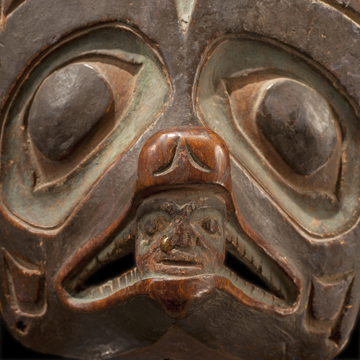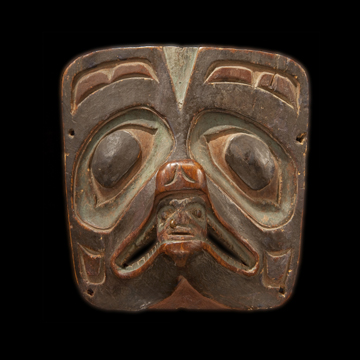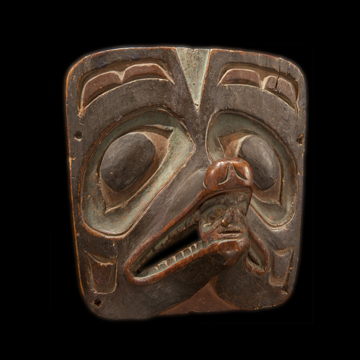The concept and tradition of an ermine-skin headdress with a carved wooden frontlet is said by native oral history to have originated among the Nishga’a of the Nass River valley at some unknown time.
From there the tradition dispersed by way of marriage, gifting, and warfare among the other northern Northwest Coast peoples, the Tlinglit and Haida, who lived on the islands and seacoast to the west and north of the Nass River.
Early examples of Tlinglit frontlets collected by European explorers in the late eighteenth century indicate that the tradition had been well entrenched in that area for a long period of time. By the middle nineteenth century, the frontlet and headdress tradition had traveled as far south as northern Vancouver Island, where it has enjoyed a widespread and enthusiastic expression ever since. Many headdresses and carved frontlets of northern and central coast manufacture have been collected among the Kwakwaka'wakw of Vancouver Island, indicating where and from whom the tradition made its way to them. By that time, frontlets had grown in size and elaboration from what must have been their original forms.
In looking at the historical record of extant frontlets, one becomes aware of what may have been the progression of their development from simple to more elaborate sculptural forms, and a similar progression in the use and elaboration of abalone shell inlays. The earliest frontlets, as shown by the documented examples collected in the late eighteenth century, employed minimal or even no shell inlay. Though there was often a thin rim bordering the central sculptural figure, no inlay was used on the rim, the only embellishment being fine parallel grooving across its width. Abalone shell was a rare commodity imported by trade from far to the south in California and Mexico, which raised their value and cultural status. Native abalone was abundant, but the comparatively small shells have a pale and irregular interior, making them less suitable for inlay.
By the mid-nineteenth century, frontlets with multiple figures and numerous small inlays, including fully inlaid outer rims, were to be found in all the tribal styles of the northern and central coast. Much rarer and less often encountered are examples with simpler sculptural forms and minimal inlays, along with other early design characteristics, which must have been the older examples from which the later, more elaborate expressions of the form evolved.
This small, unusual frontlet appears to be just such a rare and very early example of the tradition. Lacking a bordering rim, the carving is composed of just the central image, probably representing a bear or wolf. The snout of the creature extends out from the fairly flat form of the face, and the head of a human being is carved there between the teeth at the end of the mouth. The snout is fairly long and narrow, which suggests a wolf is represented, but the low ears may argue in favor of the bear identification. The frontlet contains no abalone shell inlay, and the face is made up of a formline composition with early archaic style characteristics.
The tiny human face has a particularly archaic sculptural form that reflects the archaic two-dimensional design of the major face. Four small holes were drilled close to the outer edges, through which the frontlet was sewn to the headdress form that supported it.
Here and there in museums and private collections can be found the interim examples that appear to bridge the gap between very early forms like this frontlet and the more elaborate and numerous examples of the nineteenth century. The two-dimensional design-form of the creature’s face in this frontlet is an early precursor to a chain of related examples with increasing degrees of elaboration. Based on the two-dimensional painting style with deep relief carving in the unpainted areas, frontlet faces with this basic structure can be found surrounded by thin grooved rims with no inlay as well as very elaborate examples with dozens of small inlay pieces in the faces and surrounding rims. Each finished frontlet appears to have provided inspiration to successive artists who further developed the original idea with greater elaboration and expression, carving for the clan leaders who wore these ceremonial headpieces in dances that demonstrated a peaceful introduction between hosts and visitors. In the hands of the artists of many successive tribes and regions the characteristics of headdress frontlets evolved in many different directions, though always retaining the central figure, or figures, and basic forms of the original tradition.
The survival of very early examples like the subject frontlet tells us a great deal about the origins and evolutionary development of not only the frontlet tradition, but the history of the greater Northwest Coast art tradition as well.
Provenance: Dundas Collection


